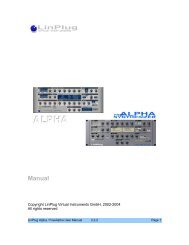Alpha Series User Manual - LinPlug Virtual Instruments
Alpha Series User Manual - LinPlug Virtual Instruments
Alpha Series User Manual - LinPlug Virtual Instruments
You also want an ePaper? Increase the reach of your titles
YUMPU automatically turns print PDFs into web optimized ePapers that Google loves.
Appendix E: Using TUN Files<br />
By Jacky Ligon<br />
About Microtuning<br />
Microtuning, or "microtonality" are methods for tuning musical instruments whereby<br />
musicians may explore and compose with ethnic, historical and contemporary tuningsystems.<br />
Microtuning musical instruments allows one to use scales which may have<br />
pitches lying between the notes of our familiar Western 12 tone scale. These<br />
pitches which are found in the 'cracks' of 12 Tone Equal Temperament are one of<br />
the things that give music's of Bali, India, Africa, Thailand, Turkey and the Middle<br />
East (to name but a few) a special intonational flavor, but is something that is of<br />
immeasurable value to the contemporary acoustic and electronic composer, who<br />
may require a more broad palette of musical pitches for their music.<br />
The quest for creating beautiful and musically useful tuning-systems has been an<br />
unending process of discovery and debate amongst musical theorists,<br />
mathematicians, physicists and musicians going back to early history. Quite often<br />
the reasons for microtuning instruments may involve improving the consonant<br />
intervals of a tuning-system for sweeter sounding harmonies, as well as offering<br />
wider variety of choices for melody. "Microtuning" an instrument can sometimes<br />
mean there may be less or more than 12 tones in an octave, or even that the octave<br />
itself may be stretched or compressed. Microtuning is a vast topic, rich with lore,<br />
music and an infinity of musical possibilities for the sonic explorer.<br />
Creating TUN microtuning files with SCALA<br />
Scala is a freeware utility developed by Manuel Op de Coul in the Netherlands,<br />
which can be used for the creation and analysis of historical, ethnic and<br />
contemporary microtunings. A powerful capability of Scala is that it enables the user<br />
to create the proprietary tuning data required for microtuning a wide range of<br />
hardware and software synthesizers and samplers.<br />
Scala may be used to create the TUN format microtuning-files needed to explore<br />
microtunings with this instrument.<br />
The Scala home page is http://www.xs4all.nl/~huygensf/scala/<br />
Specifying the Reference Frequency of a Microtuning<br />
One of the powerful capabilities of the TUN file format and Scala, is the ability to<br />
specify the pitch and midi note which will be the reference pitch for the microtuning in<br />
use. This becomes a very important consideration when one is using a number of<br />
different synthesizers and wishes to keep them in tune with a given base frequency.<br />
It is very common for one to specify a chosen concert pitch such as A440 Hz or<br />
<strong>LinPlug</strong> <strong>Alpha</strong> <strong>Series</strong> <strong>User</strong> <strong>Manual</strong> 3.0 Page 28












